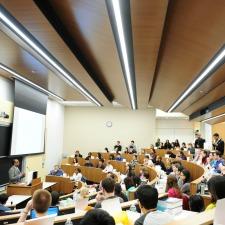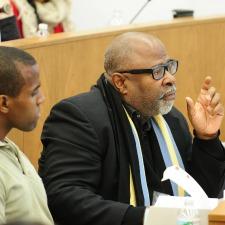Covenants and Conventions: How Legally Unenforceable Agreements Segregated America
The Makeup of U.S. Communities Continued To Be Influenced by Racially Restrictive Property Agreements Long After the Agreements Were Outlawed by the Supreme Court, Professor Richard Brooks Recounted in the Clifford Chance Lecture
New York, December 16, 2013—Although the U.S. Supreme Court in 1948 struck down judicial enforcement of racially restrictive covenants crafted to prevent people of certain races from buying property, the agreements continued to influence the way residential communities were formed for decades, according to Columbia Law School Professor Richard R.W. Brooks, who described the covenants in a riveting lecture presented as part of the Clifford Chance Thought Leadership Initiative on Diversity.
| Professor Richard R.W. Brooks |
Brooks, a renowned legal scholar with expertise in contracts, law and economics, and issues of racial justice, joined the faculty in July from Yale Law School as the Charles Keller Beekman Professor of Law. He addressed a standing-room-only audience of students, faculty members, and guests at the Nov. 20 event in Jerome Greene Hall, drawing from research he conducted for his latest book, Saving the Neighborhood: Racially Restrictive Covenants, Law, and Social Norms.
The agreements had an impact on housing patterns even after they were no longer supported by the law because they were discoverable in the normal title process and functioned as a “signal,” Brooks said, setting the tone for the type of behavior that was acceptable in a given community.
For example, a banker reviewing a loan application for a black customer in a neighborhood where a covenant excluded blacks would know that if the loan was extended and the customer moved in, white homeowners might flee. That, in turn, would bring property values down and affect the bank’s bottom line. So, even though the banker knew the covenant no longer had legal merit, it might still influence her decision. Bankers, real estate agents and homeowners regularly used the argument that they were “saving the neighborhood” by limiting who could move in and who could not, a justification Brooks and his co-author co-opted for the title of their book.
“It’s not merely just a question of enforcement,” Brooks said, “but of conveying information. Conveying information to banks and other real estate professionals. Conveying information to neighbors who are moving into communities, who don’t know what they should do, what the standards are.”
| Professor Brooks took questions from the standing-room-only crowd, which included Professor Kendall Thomas. |
During his presentation, Brooks said racially restrictive property agreements are an example of a main focus of his research: how the law influences the way people interact with each other. He noted that the residual impact of these covenants is present even today in racially segregated neighborhoods across the United States.
“They’re just forms,” Brooks said of the agreements. “But they are forms we can use to both identify and see the operation of deep, deep social norms.”
Brooks said there is plenty of evidence to support the idea that homeowners were harboring animus, or prejudice, when they crafted covenants to exclude people of various ethnic groups from their neighborhoods. But regardless of the intent behind the agreements, the effect is the same, Brooks explained. Market forces take over; the banker will always act in the interest of her bottom line.
“It doesn’t require racial animus to get these results,” he said. “And, in fact, part of what’s happening is that the covenants themselves are creating the norms; they’re creating the common practices of racial exclusion themselves.”
The Clifford Chance Thought Leadership Initiative on Diversity was established in 2006 by Clifford Chance to support the scholarly research of Columbia Law School faculty members examining diversity and its implications within the legal community.



